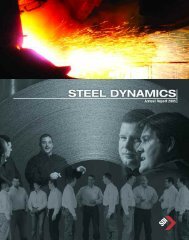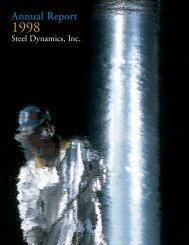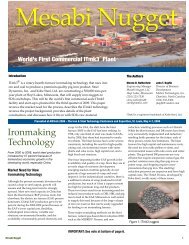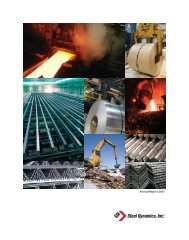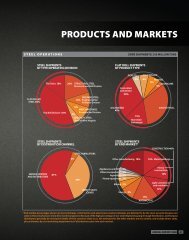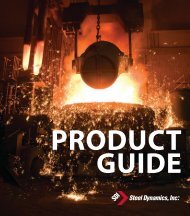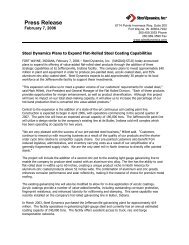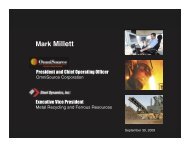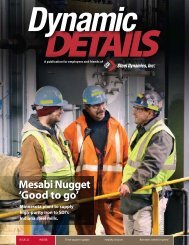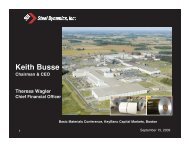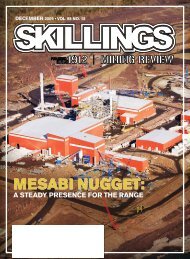ANNUAL REPORT - Steel Dynamics, Inc.
ANNUAL REPORT - Steel Dynamics, Inc.
ANNUAL REPORT - Steel Dynamics, Inc.
Create successful ePaper yourself
Turn your PDF publications into a flip-book with our unique Google optimized e-Paper software.
<strong>ANNUAL</strong><br />
<strong>REPORT</strong><br />
2006
A RECORD YEAR:<br />
VOLUME GROWTH WITH<br />
PRODUCT DIVERSIFICATION<br />
NET SALES<br />
$ millions<br />
2002–2006<br />
SHIPMENTS<br />
thousand tons<br />
2002–2006<br />
2006<br />
2005<br />
2004<br />
2003<br />
2002<br />
$3,239<br />
2,185<br />
2,145<br />
987<br />
864<br />
2006 4,688<br />
2005 3,594<br />
2004 3,432<br />
2003 2,817<br />
2002 2,390<br />
STEEL PRODUCT MIX *<br />
SHIPMENTS<br />
million tons<br />
2006 4.7<br />
2003 2.8<br />
2000 1.9<br />
Flat Roll<br />
Structural and Rail<br />
Engineered Bar Products<br />
Roanoke Bar<br />
<strong>Steel</strong> of West Virginia<br />
New Millennium<br />
* For steel and steel-fabrication business segments<br />
2000 2003 2006<br />
FINANCIAL HIGHLIGHTS (Dollars in millions, except per-share amounts)<br />
SELECTED FINANCIAL DATA<br />
2006 2005 2004 2003 2002<br />
Net Sales $3,239 $2,185 $2,145 $987 $864<br />
Operating <strong>Inc</strong>ome 659 393 507 97 158<br />
Net <strong>Inc</strong>ome 397 222 295 47 78<br />
Cash Flow from Operations 405 311 248 128 115<br />
2002–2006<br />
CASH FLOW<br />
FROM OPE<br />
$ millions<br />
2002–200<br />
NET INCOME<br />
$ millions<br />
2006 $397<br />
2005 222<br />
2004 295<br />
2003 47<br />
2002 78<br />
EARNINGS PER SHARE<br />
2006 2005 2004 2003 2002<br />
Net <strong>Inc</strong>ome per Share—Basic $4.22 $2.49 $3.00 $.49 $.83<br />
Shares Outstanding 1 93,931 89,242 98,574 95,659 94,288<br />
Net <strong>Inc</strong>ome per Share—Diluted $3.77 $2.17 $2.64 $.45 $.83<br />
Shares & Share Equivalents Outstanding 1 105,774 103,284 113,053 109,779 95,185<br />
1 Weighted average, shares outstanding adjusted for 2-for-1 split effected November 20, 2006<br />
OPERATING HIGHLIGHTS<br />
2002–2006<br />
CASH FLOW<br />
FROM OPERATIONS<br />
$ millions<br />
2006 $405<br />
2005 311<br />
2004 248<br />
2003 128<br />
2002 115<br />
2002–2006<br />
SELECTED OPERATING INFORMATION<br />
2006 2005 2004 2003 2002<br />
Operating Margin 20% 18% 24% 10% 18%<br />
Operating <strong>Inc</strong>ome per Ton Shipped $141 $109 $148 $34 $66<br />
Return on Sales 12% 10% 14% 5% 9%<br />
Consolidated Shipments (thousands of tons) 4,688 3,594 3,432 2,817 2,390<br />
Employees at Year-end 3,490 1,795 1,645 1,397 869<br />
Average Selling Price per Ton Shipped $691 $608 $625 $350 $361<br />
Forward-looking statement<br />
This publication contains predictive statements about future events. These statements are intended to be made as “forward-looking”<br />
within the safe-harbor protections of the Private Securities Litigation Reform Act of 1995. Reference is made to the “risk factors” section<br />
in SDI’s most recent Annual Report on Form 10-K, which describes the many factors and risks that may cause such predictive statements<br />
to turn out differently. A copy of the 2006 Form 10-K is included with this Annual Report.<br />
On the cover<br />
A pattern is formed by stacks of merchant-bar angles produced by SDI’s Roanoke Bar Division in Roanoke, Virginia. Learn more about these<br />
products and others produced by <strong>Steel</strong> <strong>Dynamics</strong> starting on page 7.
A LETTER<br />
TO OUR<br />
SHAREHOLDERS<br />
2006 Annual Report<br />
April 2, 2007<br />
Keith Busse, President & Chief Executive Officer<br />
2006<br />
was another outstanding year for<br />
<strong>Steel</strong> <strong>Dynamics</strong>. We achieved record<br />
shipments, record sales, record earnings,<br />
and record cash flow from operations. Net sales increased 48 percent<br />
to $3.2 billion, while consolidated shipments grew 30 percent to<br />
4.7 million tons. Net income increased 79 percent to $397 million.<br />
In addition, SDI generated $405 million in cash flow from operations.<br />
Our operating margin was 20 percent, and we earned operating<br />
income of $141 for each ton of steel shipped. I am pleased to report<br />
that during 2006, SDI’s stock appreciated 83 percent, closing at $32.45.<br />
A major contributor to the company’s record results in 2006 was<br />
the Flat Roll Division, which was our initial business and remains<br />
the company’s largest division. The Flat Roll Division’s continued<br />
strong operating performance was manifested in record shipments<br />
of more than 2.5 million tons of steel and in excellent operating<br />
profits. Our mill at Butler, Indiana, continues to be one of the most<br />
productive, highest-volume flat-rolled-steel mini-mills in the world.<br />
Also significant to note about 2006 was SDI’s growing success<br />
in the “long-products” segment of the steel marketplace. This<br />
success stems from the investments we have made in highly<br />
productive steelmaking assets over the past several years, as well<br />
as the acquisition in 2006 of Roanoke Electric <strong>Steel</strong> Corporation<br />
(Roanoke Electric).<br />
In 2006, both the Structural and Rail and the Engineered Bar<br />
Products divisions ran exceptionally well. Taking advantage of<br />
strong markets and market opportunities, they achieved record<br />
shipping volumes and gained market share. In its fifth year of<br />
operation, the structural mill at Columbia City, Indiana, rolled and<br />
shipped more than 1 million tons of structural steel, predominantly<br />
wide-flange beams. In its third year of operation, the engineeredbar<br />
mill at Pittsboro, Indiana, for the first time produced and<br />
shipped more than 500,000 tons of primarily special-bar-quality<br />
(SBQ) rounds. Both of these efficient, modern long-products mills<br />
approached their operating capacities and generated record<br />
operating profits in 2006.<br />
Likewise, the two Roanoke Electric steelmaking operations that<br />
became a part of <strong>Steel</strong> <strong>Dynamics</strong> in April 2006 achieved record<br />
shipping rates and operating profitability in 2006. The Roanoke<br />
Bar Division in Roanoke, Virginia, produces merchant bars, and<br />
<strong>Steel</strong> of West Virginia, <strong>Inc</strong>., in Huntington, West Virginia, produces<br />
a variety of light structural shapes.<br />
The integration of Roanoke Electric operations into <strong>Steel</strong> <strong>Dynamics</strong><br />
proceeded smoothly throughout the year. We are very pleased<br />
to welcome Roanoke Electric employees to the <strong>Steel</strong> <strong>Dynamics</strong><br />
family; we have been impressed with their positive attitude and<br />
their commitment to the combined company. Investments are<br />
1
eing made to modernize the acquired steelmaking and<br />
fabrication facilities.<br />
As a result of the merger and the strong volume<br />
growth in beams and SBQ bars, <strong>Steel</strong> <strong>Dynamics</strong><br />
at the end of 2006 had become a larger and more<br />
diversified steel producer. Diversification has come<br />
both in terms of a wider range of steel product<br />
offerings and end markets served by the company.<br />
Five years ago, about a third of our shipments<br />
went to the automotive industry. In 2006, due<br />
to the growth in other markets, our automotive<br />
business decreased to about 15 percent. An<br />
increasing percentage now goes to the construction<br />
market—primarily non-residential construction—<br />
while a large part of our business is spread among<br />
a variety of light commercial, industrial, business<br />
equipment, agricultural, transportation, construction<br />
equipment, mining, and other applications. On the<br />
pages following this letter, we show the breadth of<br />
our current product offerings and profile several<br />
customers to illustrate some of the diverse<br />
applications in which our steels are used.<br />
STEEL DYNAMICS:<br />
TARGETING GROWTH<br />
The consolidation of the U.S. steel industry over<br />
the past few years has been widely reported. Some<br />
have suggested the consolidation and globalization<br />
of many of the larger North American steel<br />
companies limit the opportunities for the remaining<br />
steel producers in the United States. The success<br />
of <strong>Steel</strong> <strong>Dynamics</strong> suggests otherwise; we have<br />
been, and expect to continue to be, successful in<br />
identifying and capitalizing on promising business<br />
opportunities in the U.S. steel market.<br />
<strong>Steel</strong> <strong>Dynamics</strong> efficiently produces high-quality<br />
steel products to meet specific customer needs,<br />
providing good service and reliable regional<br />
delivery, allowing us to compete effectively with<br />
larger steel companies and with imported steel.<br />
We operate some of the most efficient and<br />
productive steelmaking operations in the world.<br />
PROFIT MARGIN<br />
percent<br />
2002–2006<br />
OPERATING INCOME<br />
PER TON SHIPPED<br />
dollars<br />
2002–2006<br />
2002–2006<br />
We continue to add new products and expand our operations to<br />
focus on promising segments of the steel market. We have also<br />
moved into value-added processing of the steels we produce, such<br />
as zinc-coating and painting of flat-rolled steels, and into inspecting,<br />
sawing, turning, polishing, and heat-treating of bar steels. Targeting<br />
2006 20%<br />
2005 18%<br />
2004 24%<br />
2003 10%<br />
2002 18%<br />
2006 $141<br />
2005 109<br />
2004 148<br />
2003 34<br />
2002 66<br />
CAPITAL EXPENDITURES<br />
millions of dollars<br />
2006 $129<br />
2005 63<br />
2004 102<br />
2003 137<br />
2002 143<br />
specific growth opportunities and maintaining very<br />
productive, low-cost production operations QUARTERLY have DIVIDENDS<br />
dollars<br />
been the keys to SDI’s success.<br />
.15 $0.05 special dividend<br />
STRATEGIC DIRECTION<br />
.10 $0.10 regular dividend<br />
Recently a Wall Street analyst accurately said,<br />
“<strong>Steel</strong> <strong>Dynamics</strong> is a growth company in<br />
.05<br />
steel<br />
industry clothing.” Since our start-up and first<br />
shipments of flat-rolled steel in 1996, SDI has seen<br />
remarkable growth, not only in our volume of Q2 steel Q3 Q4 Q1 Q2 Q3 Q4<br />
2004 2005<br />
shipments and increasing revenues, but also in<br />
profits and cash flow. We expect future growth<br />
could come from a combination of organic growth<br />
of our existing steel businesses, including new<br />
products that complement our existing offerings, DILUTED EARNINGS PER<br />
and/or from acquiring assets or businesses dollars that fit<br />
our culture and business model. To accommodate<br />
internal growth, we are currently busy expanding 2006 $<br />
existing facilities and adding new operations. We 2005<br />
continue to be interested in M&A opportunities that 2004<br />
offer growth, a compatible culture, and reasonable 2003<br />
returns. This would include opportunities for<br />
2002<br />
downstream integration, along the lines of our<br />
New Millennium Building Systems steel-fabrication<br />
business, and upstream integration, such as in<br />
ferrous-resource procurement and processing, 2002–2006<br />
as well as steelmaking.<br />
With our business success, we have generated<br />
$964 million in cash flow from operations over the<br />
past three years. This cash allows us to proceed<br />
with sound investments to support our growth. In<br />
2006, our capital expenditures totaled $129 million,<br />
but they are currently expected to grow to nearly<br />
$400 million in 2007 for plant expansions and<br />
production-technology upgrades at several of<br />
our facilities.<br />
In 2006, we shipped 4.7 million tons of steel and<br />
estimate that our annualized steelmaking capacity<br />
at the end of the year was about 5.2 million tons.<br />
Projects under way that are expected to be completed in 2008<br />
should increase our steelmaking capacity to as much as 6.5 million<br />
tons per year.<br />
2
2006 BUSINESS HIGHLIGHTS<br />
It is instructive to review the operational highlights for the various parts<br />
of our business in 2006 and to discuss the improvements we are making<br />
in each division to facilitate continued profitable growth.<br />
FLAT ROLL DIVISION<br />
During the first three quarters of 2006, the market for flat-rolled<br />
steel was very strong, but it weakened in the fourth quarter as the<br />
inventories of flat-rolled steel at steel service centers rose, primarily<br />
due to an oversupply of imported steel. As the order rates slowed<br />
in the fourth quarter, <strong>Steel</strong> <strong>Dynamics</strong>, as well as other domestic<br />
producers, cut back significantly on production. Prices fell for<br />
flat-rolled steel, reducing profit margins. Nevertheless, 2006 was<br />
a very strong, profitable year for the division, with record production<br />
of hot-rolled steel as well as cold-rolled, galvanized, and painted<br />
steel. The division again benefited from the mill’s diverse product<br />
mix, including value-added coated products.<br />
Significant process improvements that were made at the Flat Roll<br />
Division in 2006 are expected to lead to a 20-percent increase in<br />
the mill’s hot-band production capacity. Modifications to Butler’s<br />
thin-slab casters, as well as related changes in the melt shop,<br />
are expected to increase the mill’s capacity from 2.5 million tons<br />
per year to 3 million tons per year. These upgrades, costing less<br />
than $15 million, were completed with minimal disruption to<br />
ongoing production.<br />
We have capitalized on an attractive business opportunity for valueadded<br />
products with our paint line at Butler, which started up<br />
in 2003 and now supplies custom pre-painted coils to a variety<br />
of end-users. It shipped 247,000 tons of painted steel in 2006,<br />
exceeding its rated capacity of 240,000 tons. In February 2006,<br />
we announced our decision<br />
to build a second paint<br />
line to be located at the<br />
division’s light-gauge<br />
galvanizing plant at<br />
Jeffersonville, Indiana.<br />
The new paint line will<br />
be dedicated to painting<br />
lighter-gauge steel than<br />
A 22-ton coil of painted, galvanized steel<br />
is hoisted to be wrapped with a protective<br />
cover for shipment. The most popular<br />
paint color? White.<br />
*Galvalume ® is a trademark of BIEC International <strong>Inc</strong>.<br />
can be painted at Butler,<br />
allowing us to enter<br />
construction markets that<br />
we have not previously<br />
served, such as coated metal roofing. We also plan to add the<br />
capability to produce corrosion-resistant Galvalume* and acryliccoated<br />
steels at Jeffersonville. Construction for this project is<br />
in progress, and we plan to begin shipping these products during<br />
the third quarter of 2007.<br />
STRUCTURAL AND RAIL DIVISION<br />
The non-residential construction market, which began to show<br />
strength in the second half of 2005, gained significant momentum<br />
in 2006. The Structural and Rail Division, which produces beams<br />
for the construction market, broke into new territory as its order<br />
backlog continued to grow.<br />
Monthly production and<br />
shipping rates grew<br />
throughout the year.<br />
Amid high product demand,<br />
the division performed<br />
a juggling act to meet<br />
customer requirements,<br />
and gained the respect<br />
of established and new<br />
customers by not overpromising<br />
and by shipping<br />
promised orders on time.<br />
In 2006, the cooling bed at the Columbia City<br />
structural mill was extended 80 feet to handle<br />
wide-flange beams and rail sections up to<br />
320 feet in length.<br />
The mill shipped more than 1 million tons of wide-flange beams<br />
and H-piling in 2006, close to the mill’s capacity, considering the<br />
mix of product sizes produced. Structural-steel pricing remained<br />
strong all year.<br />
The Columbia City mill is equipped to produce rail as well as<br />
beams, but because the demand for beams was so strong,<br />
SDI made the decision early in the year to postpone offering rail<br />
for sale to the Class I railroads.<br />
In April 2006, we announced a $200 million expansion of the<br />
Columbia City facility that includes modifications to melting and<br />
casting operations and the addition of a second rolling mill. This<br />
new medium-section mill will produce the lighter sections currently<br />
produced on the existing rolling mill, freeing up time on the existing<br />
3
mill for rail production. When in full operation, the combined<br />
facilities are expected to be able to produce about 1.8 million<br />
tons of steel per year, of which rail production could be 300,000<br />
to 350,000 tons. The mill expansion is planned for completion<br />
by the end of 2007 with start-up early in 2008.<br />
ENGINEERED BAR PRODUCTS DIVISION<br />
The Engineered Bar Products Division at Pittsboro, Indiana, made<br />
significant progress in 2006 in gaining qualification of its products<br />
with a number of important customers. The nature of this business<br />
is such that products must be engineered to meet the specific<br />
requirements of the customer’s application. Evaluation samples<br />
are provided for customer testing—and must gain customer<br />
approval before orders are placed. Once our products are<br />
qualified, we stand a good chance of gaining the business and,<br />
in some cases, winning long-term supply contracts. In 2006,<br />
we made excellent progress in this arena.<br />
Recognizing the performance that the Engineered Bar Products<br />
Division has achieved in fine-tuning its steel-manufacturing<br />
processes to produce high-grade steels, Caterpillar recently<br />
awarded <strong>Steel</strong> <strong>Dynamics</strong> its 2006 Quality Excellence Award.<br />
This award cites <strong>Steel</strong> <strong>Dynamics</strong> for “providing defect-free<br />
SBQ steel to Caterpillar N.A. in 2006.”<br />
During the second quarter of 2006, Pittsboro began operation<br />
of its new on-site $18 million bar-finishing facility. A key capital<br />
investment to support the division’s growth, this facility performs<br />
a variety of finishing and inspection operations that are required<br />
by some customers and are a convenience to others. These<br />
processing services provide additional revenue and enhance<br />
the division’s margins, while meeting customer requirements<br />
for finished and inspected products.<br />
In March 2007, we announced plans for an additional investment<br />
of $35 million to modify the engineered-bar mill to improve<br />
process flow through casting and rolling operations. This<br />
investment is expected to increase the mill’s annual capacity<br />
to about 725,000 tons from its current capacity of 500,000 tons.<br />
ROANOKE BAR DIVISION<br />
In a strong market for its products throughout 2006, the Roanoke<br />
Bar Division achieved record shipments and sales. The Roanoke<br />
Bar Division is SDI’s newest division: the flagship mill of the former<br />
Operator Tony Jovevki polishes and straightens<br />
SBQ bars at the new Engineered Bar<br />
finishing facility at Pittsboro, Indiana.<br />
4
Roanoke Electric <strong>Steel</strong> Corporation. Roanoke has earned a<br />
reputation as a respected supplier of merchant bars—including<br />
angles, rounds, channels, and flats—and has consistently received<br />
awards for its high level of customer service. It primarily serves<br />
steel service centers and OEMs in the eastern United States.<br />
A significant volume of its finished products is supplied to the<br />
company’s joist-fabrication plants.<br />
We are pleased that Joe Crawford, former president of Roanoke<br />
Electric, has stayed on as a vice president of <strong>Steel</strong> <strong>Dynamics</strong> and<br />
general manager of the Roanoke division. He and the Roanoke<br />
mill managers have been very effective during the transition in<br />
implementing SDI’s<br />
incentive-compensation<br />
programs, which have<br />
already resulted in<br />
increased mill output<br />
and higher pay for the<br />
mill’s employees.<br />
Roanoke Electric was the first American<br />
steelmaker to employ continuous-casting<br />
technology to produce steel. Today, the<br />
Roanoke Bar Division casts strands of billets<br />
four at a time.<br />
The Roanoke mill’s<br />
raw-steel production<br />
capacity exceeds its<br />
rolling capability, allowing<br />
the mill to sell a portion<br />
of the billets that it casts.<br />
Plans are under way to<br />
utilize the excess billet production by increasing rolling-mill output<br />
through a combination of investment in new equipment and changes<br />
in operations. An investment of between $40 million and $50 million<br />
is planned to upgrade the Roanoke melt shop and rolling mill.<br />
These improvements are expected to increase the mill’s billet capacity<br />
to 750,000 tons per year and rolling capacity to 550,000 tons<br />
per year. The mill produced and shipped at a record rate in 2006,<br />
shipping 458,000 tons, post-merger with <strong>Steel</strong> <strong>Dynamics</strong>.<br />
STEEL OF WEST VIRGINIA<br />
<strong>Steel</strong> of West Virginia (SWVA) is a wholly owned subsidiary of<br />
<strong>Steel</strong> <strong>Dynamics</strong> acquired with the Roanoke Electric merger. SWVA<br />
operates a steel mill in Huntington, West Virginia, and a fabricating<br />
plant, Marshall <strong>Steel</strong>, in Memphis, Tennessee. The company produces<br />
a wide range of light structural carbon-steel products and specialty<br />
shapes, many of which are engineered for custom applications.<br />
SWVA is sole-source supplier of a number of products, including<br />
steel products used in the manufacture of fork-lift trucks and<br />
over-the-road truck trailers.<br />
Tim Duke, who has served<br />
as the president of SWVA,<br />
<strong>Inc</strong>., since 1987, continues<br />
to serve as president and<br />
is now a vice president of<br />
<strong>Steel</strong> <strong>Dynamics</strong>. With his<br />
management team, Tim<br />
has effectively managed<br />
this business to establish<br />
its strong position in a<br />
number of niche markets<br />
for carbon-steel shapes.<br />
We are pleased with the<br />
performance of <strong>Steel</strong> of<br />
West Virginia and believe its employees share a strong commitment<br />
to the continued success of the business.<br />
The Huntington mill produces only some of the billets it needs for<br />
rolling its products. Additional billets are supplied by the Roanoke<br />
Bar Division. SWVA has an annual rolling capacity of approximately<br />
350,000 tons per year. The demand for SWVA’s products was<br />
strong throughout 2006. After the April merger, SWVA shipped<br />
237,000 tons.<br />
NEW MILLENNIUM BUILDING SYSTEMS<br />
2006 was a transition year for New Millennium Building Systems<br />
as it focused on integrating into its business the three joistmanufacturing<br />
plants that were acquired in the merger with<br />
Roanoke Electric: the John W. Hancock plant in Salem, Virginia, and<br />
the Socar plants in Florence, South Carolina, and Continental, Ohio.<br />
These operations produce<br />
steel joists, trusses, and<br />
girders for use in nonresidential<br />
buildings. The<br />
acquired operations enjoy<br />
a strong market position<br />
in their regions, but their<br />
facilities were in need<br />
of updating with new<br />
production equipment and<br />
methods to reduce costs<br />
and streamline production<br />
A robotic welder attaches an end plate to<br />
a trailer beam at the <strong>Steel</strong> of West Virginia<br />
plant in Huntington. SWVA uses automated<br />
welding when fabricating high-volume<br />
products, while manually welding those<br />
with lower volumes.<br />
A large industrial truck at New Millennium’s<br />
Florence, South Carolina, plant moves a stack of<br />
completed steel joists toward the shipping yard.<br />
flow. In 2006, we initiated an investment program, which will extend<br />
through midyear 2007, to prepare these facilities to operate at higher<br />
volumes and with greater efficiency. The expected cost for the<br />
5
2002–2006<br />
OPERATING INCOME<br />
upgrades of the three plants,<br />
PER<br />
including<br />
TON SHIPPED<br />
the addition of a steel-deck<br />
dollars<br />
production facility at the Salem location, is expected to be between<br />
$50 million and $60 million.<br />
2006 $141<br />
2006 was a very strong year for the original New 2005 Millennium 109 plant<br />
at Butler, Indiana. In the second year after its start-up, 2004 148 the new<br />
plant at Lake City, Florida, continued to establish<br />
2003<br />
its position<br />
34<br />
in the<br />
2002 66<br />
southeastern U.S. market. The three acquired plants operated at<br />
a somewhat reduced pace in 2006 due to the disruption caused by<br />
the modernization activity. We believe this network of five joist-anddeck<br />
plants covering the eastern half of the United States will begin<br />
to demonstrate its earnings potential 2002–2006 in the second half of 2007.<br />
SHAREHOLDER VALUE<br />
CAPITAL EXPENDITURES<br />
millions of dollars<br />
Although we believe that our continued investments in support<br />
of the future growth of the company and our consistent delivery<br />
of outstanding results are the most effective ways 2006 to enhance $129<br />
shareholder value, in 2006 we continued to pursue<br />
2005<br />
additional<br />
63<br />
2004 102<br />
avenues to reward our shareholders.<br />
2003 137<br />
QUARTERLY DIVIDENDS<br />
dollars<br />
2002 143<br />
We declared cash<br />
dividends of $.50 per<br />
.15<br />
.10<br />
.05<br />
$0.05 special dividend<br />
$0.10 regular dividend 2002–2006<br />
common share during<br />
2006, an increase over<br />
our 2005 cash dividends<br />
of $.20 per common<br />
share. Our board of<br />
directors continues to<br />
have confidence in our<br />
Q2 Q3 Q4 Q1 Q2 Q3 Q4 Q1 Q2 Q3 Q4 growth and earnings<br />
2004 2005 2006 potential and believes<br />
it is important to provide this shareholder benefit while also taking<br />
into consideration the company’s other funding requirements.<br />
In addition, in 2006 we repurchased 9.4 million shares of our common<br />
DILUTED EARNINGS PER SHARE<br />
stock<br />
dollarsat a cost of $247 million. During the last three years, we have<br />
repurchased 24.4 million shares at a cost of $489 million. At the end of<br />
the year, we had 5.6 million authorized shares remaining for repurchase.<br />
2006 $3.77<br />
On November 20, 2006, 2005 <strong>Steel</strong> 2.17<strong>Dynamics</strong> effected a two-for-one<br />
split of our common 2004 stock. 2.64 At year-end, there were 97 million<br />
shares outstanding.<br />
2003 0.45<br />
2002 0.83<br />
FINANCIAL CONDITION<br />
Our total outstanding debt was $439 million at the end of 2006,<br />
and 2002–2006 our long-term debt-to-capitalization ratio was 26 percent. We<br />
had outstanding borrowings of $80 million under our $350 million<br />
senior secured revolving line<br />
of credit, resulting in liquidity<br />
of $299 million. We believe<br />
that with our current levels<br />
of operations and anticipated<br />
growth, and with other<br />
available sources of funding,<br />
we have more than sufficient<br />
sources of funds to support<br />
our current growth plans.<br />
SAFETY<br />
Nothing at <strong>Steel</strong> <strong>Dynamics</strong> is more important than the health,<br />
safety, and well-being of our employees and their families. As we<br />
added the Roanoke operations, we undertook an extensive program<br />
to emphasize the importance of safe practices in the workplace,<br />
including investments in new and improved safety equipment. As<br />
we strive to maintain and continually improve our strong safety<br />
record, we expect equally strong employee commitments to their<br />
personal safety and that of others, making safety a top priority in<br />
our daily work activities.<br />
EMPLOYEE-DRIVEN SUCCESS<br />
DILUTED EARNINGS PER SHARE<br />
dollars<br />
In closing, I want to thank our employees for their steadfast efforts<br />
in making 2006 such a successful year for <strong>Steel</strong> <strong>Dynamics</strong>. This<br />
includes the new members of our family who joined us from<br />
Roanoke Electric, many of whom had contributed long years<br />
of service at Roanoke. They, as well as employees at our other<br />
operations, continue to set new performance goals, work<br />
to achieve them, and often exceed them.<br />
Our culture of rewarding individual and team initiative through<br />
incentive-compensation programs tailored to each work unit has<br />
proven very successful. All of our employees participate in annual<br />
profit sharing, and are very well compensated through incentivebonus<br />
programs. Aligning employees’ interests with those of the<br />
company results in success for both.<br />
I am very proud of the strong commitment our employees make<br />
each and every day. That commitment is one of the most important<br />
elements in the company’s success—today and in the future.<br />
Sincerely,<br />
2002–2006<br />
Keith Busse<br />
2006 $3.77<br />
2005 2.17<br />
2004 2.64<br />
2003 0.45<br />
2002 0.83<br />
6
PRODUCTS<br />
ENGINEERED BARS 10%<br />
AND MARKETS<br />
STRUCTURAL 20%<br />
Hot-rolled galvanized 9%<br />
Painted 5%<br />
<strong>Steel</strong> <strong>Dynamics</strong> produces a wide range of steel products<br />
at 12 production facilities across the eastern United States.<br />
The next four pages show photos of the company’s products<br />
and provide brief descriptions. Then, on the following pages,<br />
we provide a small sampling of the many applications in which<br />
our products are used. Visiting our customers’ operations offers<br />
insights not only into how our steel is used, but also into who<br />
these customers are and the high regard they have for <strong>Steel</strong><br />
<strong>Dynamics</strong> as a supplier. These examples are representative<br />
of hundreds of customers and thousands of applications<br />
for our products.<br />
2006 SHIPMENTS BY PRODUCT TYPE<br />
CONSTRUCTION (based on tons 42% shipped)<br />
AUTOMOTIVE 15%<br />
JOISTS AND DECKING 5%<br />
MINING/ENERGY 10%<br />
SMALL OTHER TRANSPORTATION STRUCTURAL (SWVA) 9% 5%<br />
INDUSTRIAL 9%<br />
MERCHANT BARS (ROANOKE) 9%<br />
AND AGRICULTURE BILLETS 4%<br />
ENGINEERED ALL OTHER 11% BARS 10%<br />
STRUCTURAL 20%<br />
FLAT ROLL 51%<br />
Hot band 23%<br />
Pickled and oiled 2%<br />
Cold-rolled 2%<br />
Cold-rolled galvanized 10%<br />
Hot-rolled galvanized 9%<br />
Painted 5%<br />
2006 SHIPMENTS BY MARKET*<br />
(based on tons shipped)<br />
CONSTRUCTION 42%<br />
AUTOMOTIVE 15%<br />
MINING/ENERGY 10%<br />
OTHER TRANSPORTATION 9%<br />
INDUSTRIAL 9%<br />
AGRICULTURE 4%<br />
ALL OTHER 11%<br />
* Note: Market-category percentages shown are our best estimates. Significant steel<br />
shipments are made to steel service centers that do not report to us the end uses<br />
of steel they sell to their customers. Our end-use estimates for automotive and<br />
construction markets are believed to be most accurate because product-to-market<br />
tracking is more transparent.<br />
Data shown include steel and steel-fabrication business segments.<br />
7
FLAT ROLL DIVISION<br />
Cold-rolled galvanized<br />
The Flat Roll Division produces hot-rolled steel, finishing<br />
and coating a high proportion of the coils it produces.<br />
The hot mill can produce coils up to 61 inches wide and<br />
specializes in thin-gauge, high-strength alloy steels that<br />
can be rolled down to .045-inch thickness. Cold-finishing<br />
mill capabilities include pickling, cold-rolling, tempering,<br />
annealing, galvanizing, and painting of coils.<br />
Hot-rolled<br />
Pickled<br />
Hot-rolled galvanized<br />
Cold-rolled tempered<br />
Cold-rolled galvanized<br />
Painted<br />
8
STRUCTURAL AND RAIL DIVISION<br />
Wide-flange beams<br />
JOISTS AND DECKING 5%<br />
The Structural and Rail Division produces wide-flange<br />
beams with web heights ranging from 6 inches to 36 inches<br />
(see photo) in a range of flange sizes and weights. It also<br />
produces H-piling, a related product driven into the ground<br />
to support buildings. The mill has the capability to produce<br />
rails, which to date have been sold in limited quantities.<br />
FLAT ROLL 51%<br />
H-pile<br />
SMALL STRUCTURAL (SWVA) 5%<br />
MERCHANT BARS (ROANOKE) 9%<br />
AND BILLETS<br />
ENGINEERED BARS 10%<br />
Industrial rail<br />
Hot band 23%<br />
Pickled and oiled 2%<br />
Cold-rolled 2%<br />
Cold-rolled galvanized 10%<br />
Hot-rolled galvanized 9%<br />
STRUCTURAL 20%<br />
Painted 5%<br />
ENGINEERED BAR PRODUCTS DIVISION<br />
Rounds<br />
The Engineered Bar Products Division produces special-barquality<br />
steel (SBQ) in round bars ranging from 1 1 /2-inch to<br />
9-inch diameters. Its products are typically high-strength<br />
carbon or alloy steel custom-formulated to meet demanding<br />
customer specifications. The division also has capabilities<br />
to provide a variety of bar-finishing and testing services.<br />
Round-corner squares<br />
Finished bar<br />
9
ROANOKE BAR DIVISION<br />
Angles<br />
Flat bars<br />
Structural channels<br />
Rounds<br />
The Roanoke Bar Division<br />
produces a broad range<br />
of standard carbon-steel<br />
merchant bars. These<br />
JOISTS AND DECKING 5%<br />
include angles ranging from<br />
1- to 4-inch; 3-inch and<br />
4-inch SMALL channels; STRUCTURAL flats from (SWVA) 5%<br />
1 to 6 inches wide; strips;<br />
and MERCHANT round bars BARS up to (ROANOKE) 1 inch 9%<br />
in diameter.<br />
AND BILLETS<br />
In addition, the<br />
Roanoke ENGINEERED hot mill BARS produces 10%<br />
excess billets for use at<br />
SWVA and for resale to<br />
STRUCTURAL 20%<br />
other companies.<br />
STEEL OF WEST VIRGINIA, INC.<br />
Mine rail<br />
Truck trailer crossmembers<br />
Industrial truck components<br />
Guardrail posts<br />
Merchant sections<br />
<strong>Steel</strong> of West Virginia produces<br />
a wide variety of carbon-steel<br />
specialty shapes, as well as<br />
a line of standard merchant<br />
shapes and light structural steel.<br />
A major product is fabricated<br />
trailer beams for use in truck<br />
trailers and truck bodies. SWVA<br />
also supplies OEMs with customengineered<br />
asymmetric shapes<br />
for unique applications.<br />
10
NEW MILLENNIUM BUILDING<br />
STRUCTURAL<br />
SYSTEMS<br />
20%<br />
Joists<br />
Decking<br />
New Millennium Building Systems produces two types of steel products, both used in the<br />
construction of non-residential buildings. One type is fabricated joists, trusses, and girders<br />
used to support a building’s roof and floors. The other type is decking, which is applied<br />
over the joists to serve as a base for the floor or roofing.<br />
11
FLAT ROLL DIVISION
A REWARDING<br />
COMBINATION<br />
With help from SDI<br />
and New Process <strong>Steel</strong>,<br />
Amarr Garage Doors<br />
continues to grow as<br />
one of America’s foremost<br />
garage-door makers.<br />
13
Delbert Phlipot<br />
SDI’s Flat Roll Division<br />
is a top supplier of<br />
painted steel coil to the<br />
domestic garage-door<br />
industry. Its partner<br />
for a portion of this<br />
business is New<br />
Process <strong>Steel</strong>,<br />
a Texas-based steel service center with five locations<br />
around the country, including one at Butler, Indiana,<br />
just down the road from SDI’s flat-roll mill. New Process,<br />
which specializes in coated-steel products, is a substantial<br />
SDI customer.<br />
Even though several garage-door makers buy their<br />
steel directly from New Process, SDI is part of a unique<br />
collaboration with New Process and the manufacturers it<br />
supplies. A good example of this is the working relationship<br />
between New Process, SDI, and Amarr, one of the nation’s<br />
foremost producers of raised-panel steel residential<br />
and commercial garage doors.<br />
“People in these three organizations have the same mindset,”<br />
says Delbert Phlipot, vice president of manufacturing for<br />
Amarr, which is based in Winston-Salem, North Carolina,<br />
but whose principal factory is in Lawrence, Kansas. “We<br />
get together several times a year to devise ways to stay<br />
competitive, to reduce costs, to look at the whole supply<br />
chain.” SDI has also worked with New Process and Amarr<br />
to develop steel products with custom properties that meet<br />
Amarr’s applications. And when there’s been a steel shortage,<br />
SDI and New Process have kept Amarr in supply. “That,”<br />
Phlipot says, “has allowed us to grow our business.”<br />
Amarr, which had sales of more than $300 million in 2006,<br />
has grown at about 15 percent per year since 1998, when<br />
it bought out the second of its two partners and became an<br />
independent company, producing garage doors under the<br />
Amarr name. Today, Amarr sells to installing dealers through<br />
65 distribution centers around the world. It has established<br />
business with Lowe’s, Sears, and Costco, plus a new Lowe’s<br />
program to stock Amarr-manufactured “Reliabilt” brand<br />
doors at about 1,200 of its retail stores. Amarr has a<br />
Customer Service Call Center in Lawrence that handles<br />
the Lowe’s orders and lines up installation and collections.<br />
“SDI, New Process, and Amarr have a relationship based<br />
on great trust and integrity,” Phlipot says. “We’re on the<br />
same page when it comes to how to run a business.”<br />
PREVIOUS PAGE Finished residential-garage-door panels stacked in the staging<br />
area of Amarr’s Lawrence, Kansas, plant await shipment. The tall commercial<br />
doors marked with numbers on the back wall are Amarr products as well.<br />
BELOW, LEFT At the paint line at SDI’s flat-roll mill, steel receives a yellow prime<br />
coat. “Having steel painted at the mill where it’s made reduces damage by taking<br />
another set of hands out of play,” says Amarr’s Delbert Phlipot. BELOW, RIGHT<br />
Wrapped painted-steel coils are stacked in Amarr’s receiving area, fresh off trucks<br />
from New Process <strong>Steel</strong>’s Butler, Indiana, facility. New Process serves as Amarr’s<br />
inventory buffer. It handles all incoming-steel logistics for Amarr and performs<br />
value-added work, such as coil slitting.<br />
14
Photo courtesy of Amarr Garage Doors<br />
ABOVE, LEFT An Amarr employee insulates garage-door panels. Customers have<br />
three insulation choices, up to R12. The Lawrence facility has 685 employees<br />
working on three shifts. ABOVE, RIGHT These carriage-house doors are part of<br />
Amarr’s Classica Collection. Their appearance notwithstanding, these are actually<br />
overhead doors. “We’re very proud of the aesthetics of our doors,” says Phlipot.<br />
BELOW These partially finished doors have been textured with a pattern that<br />
resembles wood grain, roll-formed, and cut to length. Now they’re ready<br />
for hardware and insulation, after which they’ll await shipping in the staging area.<br />
15
FLAT ROLL DIVISION
A PREFERRED<br />
WAY TO<br />
OPERATE<br />
Knapheide Manufacturing<br />
prefers to rely on deeper<br />
relationships with fewer<br />
suppliers. SDI is glad<br />
to be one of them.<br />
17
Peggy Magliari<br />
Each workday, four<br />
to five New Process<br />
<strong>Steel</strong> trucks arrive<br />
from Chicago at the<br />
Quincy, Illinois, factory<br />
of The Knapheide<br />
Manufacturing Company.<br />
The trucks deliver galvanneal sheet made by the Flat Roll<br />
Division and processed—slitted, punched, stamped, and,<br />
in some cases, fabricated—by New Process. This steel is<br />
used to construct the 150 service- and utility-truck bodies<br />
Knapheide makes each day. With 50 percent of the market,<br />
Knapheide is the largest U.S. manufacturer of these products.<br />
Knapheide is an excellent example of the advantages<br />
of SDI’s partnering with a steel service center to meet the<br />
needs of a customer. Knapheide is a direct customer of<br />
New Process <strong>Steel</strong>. New Process is a direct customer<br />
of SDI. New Process chose to introduce SDI to Knapheide a<br />
few years ago to facilitate an even more productive working<br />
relationship—a move Knapheide heartily approved.<br />
Knapheide employee. “After all, our primary component<br />
is steel. It makes sense for SDI to understand who we are<br />
and how we use their product.”<br />
Magliari says Knapheide has sought to reduce the number<br />
of suppliers it deals with, favoring deeper, long-lasting<br />
vendor relationships that bring continuity of supply and<br />
service—and considerable growth potential. “We have a<br />
high degree of confidence in our alliance with New Process<br />
and SDI,” Magliari says. Both are bent on solving problems<br />
quickly: “We were extremely pleased that three people from<br />
SDI came here to see some difficulties we were dealing<br />
with on the shop floor,” she says. “SDI identified the problem,<br />
told us what they were going to do about it, and then did it.<br />
That’s an excellent attitude.”<br />
“We were founded in 1848, so we’re used to taking a longer<br />
view of things, used to dealing with people for a long time.<br />
It’s our natural and preferred way to operate,” says<br />
H.W. “Knap” Knapheide III, the fifth president of the company,<br />
founded by his great-great-grandfather to build wooden<br />
wagons for farmers.<br />
“It’s in our best interest to be recognized as the end-user,”<br />
says Peggy Magliari, director of materials and a 23-year<br />
PREVIOUS PAGE Working on one of seven assembly lines at the Knapheide plant<br />
in Quincy, Illinois, a welder secures an inner compartment into a “KUV”—<br />
Knapheide Utility Vehicle—an enclosed unit that will be installed on a pickup truck<br />
chassis. BELOW, LEFT Knapheide offers more than 150 different truck-body<br />
designs for a wide range of sizes and types of utility vehicles. Each unit is fully<br />
customizable to meet customer specifications. BELOW, RIGHT The key to<br />
Knapheide’s flexibility is a computer-aided design and manufacturing system<br />
using a CNC machine that laser-cuts and punches steel panels from large sheets<br />
of galvanized steel. Within four-and-a-half hours of the cutting of the steel panels,<br />
the steel becomes part of a completed utility body, ready for painting.<br />
18
ABOVE, LEFT Completed units emerge on a conveyor from the painting operation,<br />
where the entire body is dunked in a huge tank to receive a thorough anti-corrosive<br />
primer. Covered truck bodies, such as the KUVs, may each contain as much as<br />
a ton of steel, with about one-half of the steel being a special anti-corrosive<br />
galvanneal steel made by SDI. ABOVE, RIGHT A completed KUV is outfitted to<br />
transport tools and materials for a variety of users ranging from local plumbers<br />
and electricians to corporate fleets owned by telecommunications, construction,<br />
oil-service, and industrial-service companies as well as gas and electric utilities.<br />
KUVs are also used in fleets operated by the various levels of government.<br />
Knapheide sells its units through distributors, operates a multistate network of<br />
“company stores” that finish and customize the truck bodies, and is a primary<br />
national OEM-supplier of utility- and service-bodies for commercial vehicles sold<br />
through the dealer networks of the Detroit Three auto companies. BELOW Large<br />
primed KUV bodies are stacked outside for shipment to facilities where each unit<br />
will be finish-painted (most likely white), mounted on a truck chassis, and outfitted<br />
with a number of custom extras.<br />
19
STRUCTURAL AND RAIL DIVISI
ON<br />
CLOSE<br />
AT HAND<br />
SDI is the only producer<br />
of structural steel<br />
in the Midwest—<br />
good news for fabricators<br />
like Helgeson <strong>Steel</strong>.<br />
21
Before the structural<br />
steel that SDI makes<br />
can be used in a building<br />
project, a fabricator<br />
must prepare the steel<br />
beams to a contractor’s<br />
Christine Helgeson, specifications. What<br />
Fred Helgeson,<br />
Nick Bayer<br />
arrives at the fabricator’s<br />
shop are wide-flange beams of various sizes and lengths.<br />
What leaves are bundles of pieces that have been cut, drilled,<br />
punched, welded, ground, prime-painted, and clearly labeled<br />
so that iron workers at the building site can assemble them.<br />
“It’s just like a big erector set,” says Fred Helgeson,<br />
president of Helgeson <strong>Steel</strong> in Elkhart, Indiana, a fabricator<br />
that has worked primarily as a subcontractor for general<br />
contractors in northern Indiana, eastern Illinois, western Ohio,<br />
and southern Michigan since its founding 24 years ago.<br />
Pleased to have a reliable source of material close at hand,<br />
fabricators like Helgeson have become significant customers<br />
of SDI’s structural and rail mill. And because the mill has a<br />
shorter order/production cycle, it is all the more responsive<br />
to customer needs. Its location enables it to supply<br />
fabricators and wholesalers in the midwestern and eastern<br />
United States and central and eastern Canada more quickly<br />
than other structural mills.<br />
That’s especially important for Helgeson just now because<br />
the company is in the midst of its two busiest years ever.<br />
Helgeson, with 20 employees, has been working six-day<br />
weeks for over a year. A biodiesel plant at Claypool, Indiana,<br />
is its biggest project to date—more than 1,200 tons of<br />
structural steel fabricated—and has come in the midst<br />
of several other large efforts.<br />
(Interestingly, other projects Helgeson is working on include<br />
fabricating steel for contractors working on construction<br />
projects at several SDI facilities. Long before Helgeson was an<br />
SDI customer, it fabricated steel for construction of SDI’s flatroll<br />
and structural mills. On projects where Helgeson serves<br />
as prime contractor, it often subcontracts joist-and-deck<br />
work to SDI subsidiary New Millennium Building Systems.)<br />
Working with SDI has made all the difference for Helgeson<br />
during this busy period. “Week in, week out, the salespeople<br />
at SDI are extra helpful,” says Christine Helgeson,<br />
vice president of operations. “Kelly Penrod, Sandy Swing,<br />
and Rob Carter try to help us any way they can, always<br />
telling us what the mill is rolling now, what’s available<br />
now. And SDI’s piece markings—indicating heat number,<br />
size, and so on—are always very clear. That helps us.”<br />
“It’s good to work with good people,” says Nick Bayer,<br />
general manager.<br />
PREVIOUS PAGE A Helgeson employee fabricates a structural column, grinding<br />
the end of a wide-flange beam so that the steel will better accept the welds that<br />
will fasten a baseplate to it. BELOW, LEFT Baseplates for columns are drilled.<br />
BELOW, RIGHT A Helgeson worker punches connection holes in beams.<br />
22
ABOVE, LEFT Wide-flange beams prepared by Helgeson <strong>Steel</strong> have been bolted<br />
into place to support a floor in a new biodiesel plant under construction at<br />
Claypool, Indiana. Beams manufactured by <strong>Steel</strong> <strong>Dynamics</strong>’ Structural and Rail<br />
Division are employed in a variety of non-residential structures. ABOVE, RIGHT<br />
A new 200,000-square-foot distribution center for Vera Bradley Designs,<br />
a maker of designer handbags and luggage, is under construction south<br />
of Fort Wayne, Indiana. The vertical support columns and roof-support structure<br />
were fabricated by Helgeson <strong>Steel</strong> from beams provided by <strong>Steel</strong> <strong>Dynamics</strong>. The<br />
roof utilizes joists and is covered with steel decking supplied by New Millennium<br />
Building Systems. BELOW Painted beams prepared by Helgeson <strong>Steel</strong>, such as<br />
those shown in the foreground, form the framework for the large biodiesel facility<br />
being erected at Claypool.<br />
23
ENGINEERED BAR PRODUCTS D
IVISION<br />
FROM SCRAP<br />
TO FINISH<br />
When a customer needs<br />
only the best carbon<br />
and alloy steel bars,<br />
and one-stop shopping,<br />
SDI’s Engineered Bar<br />
Products Division<br />
is the place to call.<br />
25
Glenn Pushis<br />
Long round bars of<br />
high-grade carbon and<br />
alloy steel are produced<br />
at SDI’s three-year-old<br />
Engineered Bar<br />
Products Division<br />
in Pittsboro, Indiana.<br />
How is this steel used?<br />
“If equipment has moving parts that wear, and the parts<br />
have demanding mechanical requirements placed on them,<br />
then there’s a good chance that our steel goes into the<br />
parts,” says General Manager Glenn Pushis. “The special-barquality<br />
(SBQ) bars that we make are utilized in a variety of<br />
industrial machinery and transportation applications. Typical<br />
uses include axles, drive shafts, gears, and engine parts.”<br />
Located centrally in the Midwest, just west of Indianapolis,<br />
SDI’s engineered-bar mill began production in January<br />
2004. Since then, it has become a valued supplier of SBQ<br />
rounds to many manufacturers in the nation’s heartland,<br />
shipping more than 500,000 tons of steel bars in 2006.<br />
SBQ bars ranging from 1 1 /2 to 9 inches in diameter are<br />
produced at the Pittsboro mill. Nearly every application<br />
requires special metallurgy, using custom blends of scrap<br />
inputs, adding precise amounts of alloys, and “purifying”<br />
molten steel through a vacuum-degassing process. Over<br />
the past three years, Pittsboro’s metallurgists and production<br />
crews have succeeded in refining manufacturing processes<br />
to produce a wide range of specialty grades of SBQ steels.<br />
A new on-site 150,000-square-foot bar-finishing plant<br />
came on stream in the summer of 2006. While most of the<br />
mill’s output is shipped as unfinished steel, the new facility<br />
provides the capability to perform a number of processing<br />
and finishing operations, such as heat-treating, cutting,<br />
straightening, turning, polishing, and testing. This new facility<br />
can process up to a third of the mill’s current output.<br />
“Investing in the finishing operation was the next logical<br />
step,” Pushis says, “providing value-added downstream<br />
processing of our steel. Instead of our customers sending<br />
their raw-steel bars elsewhere for finishing, they now<br />
can get ‘one-stop shopping’ with us. This cuts down on<br />
their shipping, in-process inventory, and administrative<br />
costs—while also shortening order-to-delivery cycle time.<br />
Winning customer approvals for these high-value-added<br />
SBQ steel products has facilitated the division’s growth<br />
and has permitted <strong>Steel</strong> <strong>Dynamics</strong> to enter a variety<br />
of new end markets.”<br />
PREVIOUS PAGE Banded bundles of bright bars await shipment at the Pittsboro<br />
bar-finishing plant. BELOW, LEFT It’s hard to believe, but those shiny new bars<br />
began life as a mix of various grades of scrap steel. The recycled scrap steel<br />
is melted in a large electric furnace, cast into billets, and rolled into rounds while<br />
hot. Then the rolled bars are cut to length.<br />
BELOW, RIGHT In one of five furnaces at the new state-of-the-art bar-finishing<br />
facility at Pittsboro, long SBQ bars undergo heat-treating, a process that can<br />
be controlled to make the steel either harder or softer. Afterward, bars may be<br />
straightened, turned, polished, precision-cut to length, or chamfered, and undergo<br />
various types of non-destructive testing.<br />
26
ABOVE, LEFT Most of the Engineered Bar Products Division’s sales go directly to original<br />
equipment manufacturers that use the round bars in a variety of products, such as<br />
construction equipment. ABOVE, RIGHT Another application for the steel made by the<br />
Engineered Bar Products Division is the axles used in heavy-duty trucks. SBQ steel<br />
also makes its way into equipment used by the energy industry, such as pumps and<br />
generators used on offshore drilling rigs.<br />
BELOW SDI SBQ is incorporated in a variety of agricultural equipment. In addition<br />
to “rotating” applications, SBQ steel is used in some “stationary” applications,<br />
such as munitions casings and specialty tubing. While Pittsboro is primarily<br />
an SBQ mill, it occasionally accepts orders for rebar for use in the Indianapolis<br />
area. For example, rebar has been supplied for expansion of the Indianapolis<br />
International Airport and, notably, for a new football stadium under construction<br />
for the 2007 Super Bowl-champion Indianapolis Colts.<br />
27
ROANOKE BAR DIVISION
CARRYING<br />
THE LOAD<br />
Carry-On Trailer<br />
Corporation supplies<br />
big-box retailers with<br />
a full line of light- and<br />
medium-duty utility trailers.<br />
29
J. Pearson<br />
J. Pearson seemed<br />
destined to spend much<br />
of his life dealing with<br />
utility trailers. As a<br />
12-year-old member<br />
of Future Farmers of<br />
America, he built a utility<br />
trailer to haul bales<br />
of hay on his family’s Virginia farm. As a young man,<br />
he went to work for an Ohio company that built farm<br />
machinery, trailers, and hitches. J. ran the hitch division.<br />
Later, he became partner in a concern that sold electrical<br />
hook-ups for trailers and the cars that pulled them.<br />
Later still, J. founded Carry-On Trailer Corporation to<br />
manufacture utility trailers. His parents bet the family<br />
farm on the success of his start-up company, putting up<br />
the property as collateral on a line of credit for Carry-On.<br />
The bet paid off in a big way.<br />
Today, Carry-On Trailer Corporation—based in Lavonia,<br />
Georgia—is the nation’s largest producer of light- and<br />
medium-duty trailers. The company’s biggest customers<br />
are big-box retailers Tractor Supply, Lowe’s, and Menards.<br />
In fact, Carry-On supplies 100 percent of the utility trailers<br />
sold at these outlets. It also sells some product to<br />
independent dealers.<br />
With revenues of $144 million in 2006, Carry-On has<br />
become a multistate concern, with manufacturing operations<br />
in Virginia, Texas, Iowa, and Nevada, in addition to Georgia.<br />
An Ohio sister corporation to Carry-On manufactures light,<br />
tractor-pulled agricultural products, such as rotary cutters,<br />
graders, and hay balers.<br />
From the beginning, Carry-On has bought steel, its chief<br />
material, from Roanoke Electric <strong>Steel</strong>, now the Roanoke Bar<br />
Division of <strong>Steel</strong> <strong>Dynamics</strong>. Today, Carry-On buys angles<br />
and channels for its Georgia and Virginia plants at a rate<br />
of several truckloads per week. “I’m glad we extended<br />
favorable credit terms to Carry-On at the start,” says<br />
Parker Arthur, sales manager at Roanoke. “They’ve<br />
become one of our top-10 customers.”<br />
“We couldn’t have made it without Roanoke,” J. Pearson says.<br />
“We couldn’t have grown our business at a rate of 20 to 30<br />
percent per year without a steady supply of quality steel.”<br />
J. recently had the trailer he built as a boy moved from<br />
the family farm in Virginia to Carry-On’s 55-acre Georgia<br />
complex, where he intends to restore it. Then, late in 2007,<br />
when Carry-On manufactures its millionth utility trailer,<br />
J. plans to display the two trailers side by side at his<br />
headquarters, where he’ll explain to visitors that building<br />
trailers was his destiny.<br />
PREVIOUS PAGE Assembled trailer frames move on a conveyor line en route<br />
to be dip-painted black at Carry-On’s Lavonia, Georgia, factory. BELOW, LEFT A<br />
truckload of steel angles is prepared at the Roanoke Bar Division’s Virginia plant<br />
for shipment to Carry-On in Georgia. BELOW, RIGHT In addition to its open utility<br />
trailers, Carry-On offers a varied line of covered trailers whose undercarriages<br />
are also made of steel supplied by the Roanoke Bar Division.<br />
30
ABOVE, LEFT Each fabrication employee assembles a trailer himself. His work<br />
then undergoes rigorous scrutiny by an inspector. Only after his work has passed<br />
inspection, or after any faults have been corrected and reinspected, can a fabricator<br />
move on to the next assembly. ABOVE, RIGHT An employee applies pinstriping<br />
to the fender of a painted trailer.<br />
BELOW Finished trailers are loaded for shipment to Tractor Supply, Lowe’s,<br />
or Menards. The large foam spacer blocks help prevent damage during transit.<br />
Carry-On owns 72 trucks that deliver its trailers to big-box outlets. Drivers are<br />
trained to set up and make repairs to trailers they deliver.<br />
31
STEEL OF WEST VIRGINIA
IN IT<br />
FOR THE<br />
LONG HAUL<br />
Wabash National, a leading<br />
truck-trailer manufacturer,<br />
uses crossbeams fabricated<br />
by <strong>Steel</strong> of West Virginia.<br />
33
Tim Duke<br />
Wabash National<br />
manufactures 50,000<br />
to 60,000 truck trailers<br />
per year, most at<br />
its Lafayette, Indiana,<br />
plant. <strong>Steel</strong> of West<br />
Virginia has supplied<br />
steel crossmembers<br />
for these trailers since Wabash National Corporation was<br />
founded in 1985.<br />
These transverse-mounted trailer beams provide a platform<br />
for the trailer’s floor, and, for enclosed trailers, they support<br />
the van’s roof and sides. The beams are supplied by <strong>Steel</strong><br />
of West Virginia (SWVA) in Huntington, and by its Marshall<br />
<strong>Steel</strong> subsidiary in Memphis, Tennessee.<br />
Wabash National has achieved a leading position in the U.S.<br />
truck-trailer industry, with a 27-percent market share of the<br />
dry-freight van trailers delivered in 2006.<br />
Wabash National’s early success has been attributed to the<br />
supportive attitude of suppliers such as <strong>Steel</strong> of West Virginia<br />
that extended credit and favorable terms in supplying the<br />
steel components essential to begin trailer production.<br />
Tim Duke, president of SWVA, says the longstanding<br />
relationship with Wabash National has benefited both<br />
companies: “We take pride in supplying high volumes<br />
of steel to Wabash National, a premier builder of over-theroad<br />
trailers. Over the years, the volume of our shipments<br />
to Wabash has grown because of their success in designing<br />
and building innovative products, such as their DuraPlate ®<br />
composite trailer.<br />
“We have developed a number of proprietary process<br />
innovations to produce high-quality trailer beams—including<br />
equipment to shear, punch, and robotically weld the end<br />
plates through which the trailer’s side rails are bolted—as<br />
well as advanced coating systems. These techniques allow<br />
us to produce these products efficiently and in high volume.”<br />
The beams provided to Wabash National and other trailer<br />
manufacturers are unique in that SWVA not only makes<br />
the steel, but also performs several fabrication and finishing<br />
operations. The company also provides a number of other<br />
specialty steel products for a variety of end uses, including<br />
specially engineered shapes that are used in industrialtruck<br />
masts, conductor rails used in rapid-transit systems,<br />
and frame sections for off-highway equipment.<br />
DuraPlate ® is a registered trademark of Wabash National, L.P.<br />
PREVIOUS PAGE Welders at the Wabash National plant in Lafayette, Indiana,<br />
space steel trailer beams about a foot apart to support the trailer’s wood floor.<br />
They weld the crosspieces to steel beams that run the length of the trailer.<br />
At the ends of the crossbeams are the end plates to which the trailer’s side<br />
rails are bolted. These end plates are made from flat-rolled steel provided<br />
by SDI’s Flat Roll Division. BELOW, LEFT Crossmembers hang on a conveyor<br />
system to cool after being submerged in a bath of hot paraffin to coat them<br />
for corrosion protection. BELOW, RIGHT Stacked and banded bundles of<br />
finished trailer beams are marshaled in preparation for shipment to a Wabash<br />
National plant.<br />
34
Photo courtesy of Wabash National<br />
ABOVE, LEFT The underside of a finished trailer illustrates the large number<br />
of crossmembers used to support an oak floor and the trailer’s payload. Once<br />
trailer beams are delivered to the Wabash National plant and welded to long<br />
rails to form the trailer chassis, the side rails, sides, roof, doors, and mechanical<br />
components are added to finish a trailer.<br />
ABOVE, RIGHT A finished DuraPlate ® HD trailer shows the square pattern<br />
of exterior bolts along the side of the trailer, the bolts fastening the side of the<br />
trailer to the crossmembers of the undercarriage. Some of the vans that Wabash<br />
National builds employ outer skins made of steel. <strong>Steel</strong> <strong>Dynamics</strong> is a supplier<br />
of painted, cold-rolled galvanized steel for this purpose.<br />
35<br />
Photo courtesy of Wabash National
NEW MILLENNIUM BUILDING S
YSTEMS<br />
A HUB<br />
OF ACTIVITY<br />
Products from New<br />
Millennium Building<br />
Systems are a big part<br />
of the new student center<br />
at Tri-State University.<br />
37
Dr. Earl Brooks Michael Bock<br />
<strong>Steel</strong> from SDI plays<br />
a big role in Tri-State<br />
University’s new<br />
University Center—a<br />
project clearly illustrating<br />
the pervasiveness of<br />
steel in modern building<br />
construction. New<br />
Millennium Building Systems supplied the steel joists that<br />
support the building’s floors and roof. SDI’s Structural and<br />
Rail Division furnished wide-flange beams to give vertical<br />
support to the trusses. Flat-rolled steel from the Flat Roll<br />
Division is used in the manufacture of steel wall studs<br />
and joists, and in the building’s floor and roof decking.<br />
New Millennium Building Systems, a wholly owned<br />
subsidiary of <strong>Steel</strong> <strong>Dynamics</strong>, works hand in hand with<br />
architects and contractors to design, engineer, and fabricate<br />
custom joist-and-decking systems for buildings of many<br />
types. The curved, wide expanses of the University Center<br />
illustrate New Millennium’s engineering expertise in executing<br />
creative architectural designs to produce functional and<br />
aesthetically pleasing structures.<br />
Michael Bock, Tri-State University’s vice president for<br />
student and university operations, states, “This new<br />
$15 million building will occupy a city block at the center<br />
of our campus and will serve as the hub of student activity.<br />
It will include a commons area, cafeteria, bookstore, radio<br />
station, student offices, a 325-seat theater, and a ‘Center<br />
for Technology’—a high-tech digital library offering students<br />
wireless access to educational resources.”<br />
Tri-State University, located in Angola, Indiana, is a private<br />
university of 1,475 students, about 60 percent majoring<br />
in engineering. With SDI’s largest production facility located<br />
nearby, Tri-State and <strong>Steel</strong> <strong>Dynamics</strong> have developed a close<br />
working relationship. Keith Busse, SDI president and CEO,<br />
serves as a member of the school’s board of trustees.<br />
“We are excited about the opportunities this facility will<br />
offer our students,” says Tri-State President Dr. Earl Brooks.<br />
“<strong>Steel</strong> <strong>Dynamics</strong> is a strong supporter of the university,<br />
and we are delighted to see so much locally produced<br />
steel used in the project.”<br />
Another view of the University Center’s steel framework<br />
is shown on the opposite page. Above right are photos<br />
of buildings that are typical of the wide variety of<br />
non-residential structures for which New Millennium<br />
provides joist-and-decking systems.<br />
PREVIOUS PAGE The steel skeleton of the new University Center, under construction<br />
in February 2007, takes shape. The center’s design makes inventive use of a variety<br />
of steel products from <strong>Steel</strong> <strong>Dynamics</strong>. BELOW, LEFT New Millennium production<br />
crews—like this crew at Lake City, Florida—assemble and weld steel joists,<br />
custom-made for each building project. <strong>Steel</strong> <strong>Dynamics</strong> now operates five plants<br />
in the eastern United States producing building components. BELOW, RIGHT<br />
Finished “jobs” of steel components are shipped by truck to the building site<br />
where they’ll be erected. OPPOSITE PAGE, BOTTOM A unifying, wide, S-shaped<br />
central corridor is framed in steel. Wide-open spaces are made possible with long<br />
spans of steel.<br />
38
Dupont Hospital<br />
Fort Wayne, Indiana<br />
Georgetown Branch Library<br />
Fort Wayne, Indiana<br />
Buffalo Wild Wings<br />
Fort Wayne, Indiana<br />
Union Township Elementary School<br />
Zionsville, Indiana<br />
Tom O’Brien Chrysler Jeep<br />
Indianapolis, Indiana<br />
Vera Bradley Distribution Center<br />
Fort Wayne, Indiana<br />
Dick’s Sporting Goods<br />
Indianapolis, Indiana<br />
Andy Mohr Toyota<br />
Indianapolis, Indiana<br />
39
CUMULATIVE RETURN<br />
$700<br />
COMPARISON OF 5-YEAR CUMULATIVE TOTAL RETURN*<br />
Among <strong>Steel</strong> <strong>Dynamics</strong>, <strong>Inc</strong>., the S&P <strong>Steel</strong> Index,<br />
and the NASDAQ Composite Index<br />
600<br />
500<br />
400<br />
300<br />
200<br />
100<br />
0<br />
12/2001 12/2002 12/2003 12/2004 12/2005 12/2006<br />
<strong>Steel</strong> <strong>Dynamics</strong>, <strong>Inc</strong>.<br />
S&P <strong>Steel</strong> Index<br />
NASDAQ Composite Index<br />
* $100 invested on 12/31/01 in stock or index—including reinvestment<br />
of dividends. Fiscal year ending December 31.<br />
Copyright © 2007, Standard & Poor's, a division of The McGraw-Hill Companies, <strong>Inc</strong>. All rights reserved.<br />
www.researchdatagroup.com/S&P.htm
CORPORATE INFORMATION<br />
2003 47<br />
2002 78<br />
2006 Board of Directors<br />
Keith E. Busse<br />
President and Chief Executive Officer<br />
<strong>Steel</strong> <strong>Dynamics</strong>, <strong>Inc</strong>.<br />
NS<br />
Mark D. Millett<br />
Vice President<br />
2006 $405<br />
<strong>Steel</strong> <strong>Dynamics</strong>, <strong>Inc</strong>.<br />
2005 311<br />
2004 248 Richard P. Teets, Jr.<br />
Vice President<br />
2003 128<br />
<strong>Steel</strong> <strong>Dynamics</strong>, <strong>Inc</strong>.<br />
2002 115<br />
John C. Bates<br />
President and Chief Executive Officer<br />
Heidtman <strong>Steel</strong> Products, <strong>Inc</strong>.<br />
Frank D. Byrne, M.D.<br />
President<br />
St. Marys Hospital<br />
Medical Center<br />
Madison, Wisconsin<br />
Paul B. Edgerley<br />
Managing Director<br />
Bain Capital, <strong>Inc</strong>.<br />
Richard J. Freeland<br />
President and Chief Executive Officer<br />
Pizza Hut of Fort Wayne, <strong>Inc</strong>.<br />
Dr. Jürgen Kolb<br />
Retired<br />
Former member of Executive Board<br />
Salzgitter, AG<br />
James Marcuccilli<br />
President and Chief Executive Officer<br />
STAR Financial Bank<br />
Joseph D. Ruffolo<br />
Principal<br />
Ruffolo Benson, LLC<br />
Officers and Key Management<br />
Keith E. Busse<br />
President and Chief Executive Officer<br />
Mark D. Millett<br />
Vice President<br />
General Manager, Flat Roll Division<br />
Richard P. Teets, Jr.<br />
Vice President<br />
General Manager,<br />
Structural and Rail Division<br />
Gary E. Heasley<br />
Vice President of Finance<br />
Chief Financial Officer<br />
T. Joseph Crawford<br />
Vice President<br />
General Manager, Roanoke Bar Division<br />
Timothy R. Duke<br />
Vice President<br />
President, <strong>Steel</strong> of West Virginia, <strong>Inc</strong>.<br />
Richard J. Brady<br />
Vice President of Ferrous Resources<br />
Bert D. Hollman<br />
Vice President<br />
President,<br />
New Millennium Building Systems, LLC<br />
John W. Nolan<br />
Vice President of Sales & Marketing<br />
Glenn A. Pushis<br />
Vice President<br />
General Manager,<br />
Engineered Bar Products Division<br />
Theresa E. Wagler<br />
Vice President and Corporate Controller<br />
Janice E. Conwell<br />
Corporate Health & Safety Manager<br />
Mary L. Fink<br />
Director of Tax & Benefits<br />
Robert E. Francis<br />
Information Technology Manager<br />
Brent A. Ritenour<br />
Internal Audit Manager<br />
Fredrick A. Warner<br />
Investor Relations Manager<br />
Stockholder Information<br />
<strong>ANNUAL</strong> MEETING<br />
May 17, 2007<br />
9 a.m. Eastern/8 a.m. Central<br />
Grand Wayne Center<br />
Calhoun Ballroom<br />
120 West Jefferson Boulevard<br />
Fort Wayne, Indiana 46802<br />
STOCKHOLDER RECORDS<br />
Computershare Trust Company, N.A.<br />
P.O. Box 43078<br />
Providence, Rhode Island 02940-3078<br />
(877) 282-1168<br />
www.computershare.com<br />
INVESTOR INFORMATION<br />
Fred Warner<br />
Investor Relations Manager<br />
<strong>Steel</strong> <strong>Dynamics</strong>, <strong>Inc</strong>.<br />
(260) 969-3564<br />
Fax: (260) 969-3590<br />
www.steeldynamics.com<br />
E-mail: f.warner@steeldynamics.com<br />
CORPORATE OFFICES<br />
6714 Pointe Inverness Way, Suite 200<br />
Fort Wayne, Indiana 46804<br />
(260) 459-3553<br />
Fax: (260) 969-3590<br />
MARKET INFORMATION<br />
The company’s stock trades on the<br />
NASDAQ Global Select Market under<br />
the symbol STLD. <strong>Steel</strong> <strong>Dynamics</strong> is<br />
included in the S&P Mid-Cap 400 Index.<br />
Thanks to the customers who appear<br />
in this annual report for contributing<br />
their time and support.<br />
© 2007 <strong>Steel</strong> <strong>Dynamics</strong>, <strong>Inc</strong>.
6714 Pointe Inverness Way, Suite 200<br />
Fort Wayne, Indiana 46804<br />
(260) 459-3553<br />
www.steeldynamics.com



